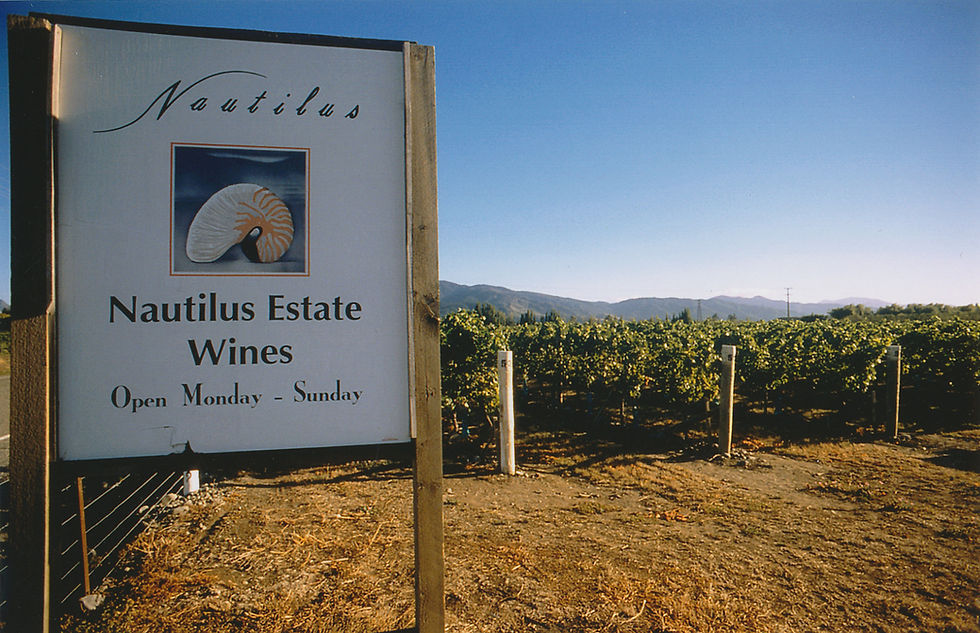Three Decades of Nautilus Chardonnay
- webadminwix
- Oct 12, 2020
- 2 min read
Updated: Feb 14, 2022

The story of Nautilus Chardonnay begins in 1989 when the first wine was made from what is now our own Nautilus Renwick vineyard (you know the classic story – we liked the wine so much, we had to buy the vineyard). This vineyard has remained the cornerstone vineyard for our Chardonnay programme ever since. Throughout the ’90s, Chardonnay grew to be a significant and successful part of the Nautilus brand. However, along with this growth came more reliance on inferior clones, machine picking and cases of random oxidation from faulty corks. Things had to change. There was a clear brief from our owner and management that it must be quality over quantity. Production was reduced from a peak of 5000 doz in the late ’90s down to about 250 doz in 2007. Clone 6 was gradually eliminated from the blend and we managed to convince some good friends of the company, Jim and Debbie Greer, to plant the new Dijon clones of Chardonnay (95 & 96). This vineyard bore fruit from 2002. We moved to screw caps in 2004.
In the meantime, we began successful trials with indigenous fermentation and once our white winery was built in 2006, we were able to chill our handpicked fruit prior to pressing. From 2007 our vineyard resource focused on clone 15 from our Renwick Estate and clone 95 from the Greers (the clone 96 was diverted to Nautilus Cuvee). From the low of 250 doz made in 2007, we began to slowly increase our volumes again and we were fortunate to secure a small block of mature clone 15 from another of our growers, Willie Crosse, in 2009. All three sites have free draining stony alluvium soils and are within 1.5 km of the winery, in the North West corner of the Rapaura sub-region. From 2007 to 2011, we refined our techniques, increasing the number of natural ferments, chilling all the fruit prior to pressing and we started pressing juice directly to barrel on full solids. We found that the less we handled the fruit & juice, the more we liked the results. Fining became unnecessary and the wine became vegan friendly as a consequence.
From vintage 2012, our aim has been to press all fruit directly to barrel (French oak, typically 20% new) and all juice undergoes natural fermentation. Most barrels undergo malolactic fermentation, however, we generally prefer to prevent malo in a few barrels to keep an element of freshness. Since 2014 the latest clones of Chardonnay in our Renwick Vineyard has started to crop. Now total production is around 70 barrels or 1600 doz. The blend is not a barrel selection but represents our entire premium Chardonnay production – every barrel is unique and precious and contributes in some way to the wine.
Now, after thirty years since that inaugural 1989 Nautilus Chardonnay release, our learnings have brought us to the point where we are fully confident in our viti-vini programme and house style and are excited to be releasing the Nautilus Chardonnay 2019.





Celebrating three decades of Nautilus Chardonnay is truly impressive — it’s fascinating to see how the character of a wine can evolve over time while maintaining its core identity. The depth of experience and care behind each vintage really comes through in this post.
As someone who explores digital storytelling and interactive content, I also enjoy learning about traditions that age gracefully — much like a good Chardonnay. If you're curious about something lighter and engaging online, you might want to check out this guide on 3 patti game play, one of the featured topics at Reddy book club, where we share unique digital experiences.
Really enjoyed this reflection on heritage and craftsmanship — thanks for sharing.
Interesting evolution! Love the commitment to quality over quantity. The shift away from inferior clones and embracing Dijon clones (95 & 96) was a smart move. The move to screw caps in 2004 certainly addressed oxidation issues. It's great to see how low-intervention techniques and vineyard focus have shaped the current style. It sounds like a smooth ride, like a Snow Rider gliding down a slope!